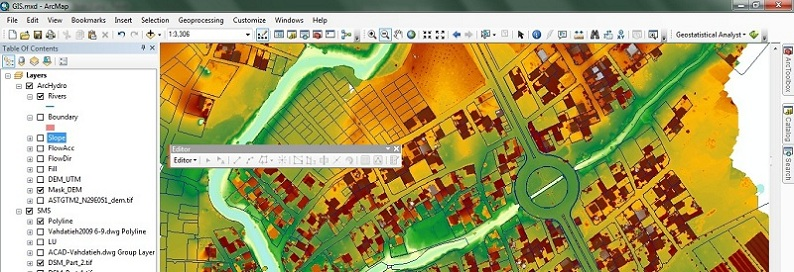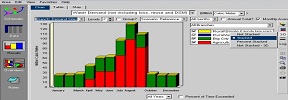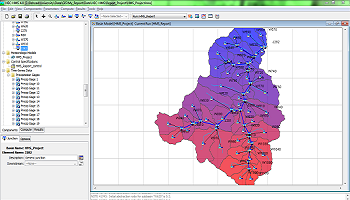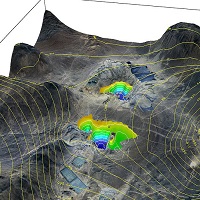دانلود داده تغییرات آب و هوایی (2006 - 2096) روزانه از NCCS ناسا با پایتون

بسیاری از مدل های گردش جهانی (GCMs) با داده های تاریخی و آینده بارش، حداکثر دما و دمای حداقل برای سناریوهای مختلف وجود دارند. داده ها در زمانبندی روزانه از سرورهای خاص در دسترس هستند، در این آموزش ویژگی های اصلی NASCAR THCSDS Data Server را نشان می دهیم که مجموعه داده های روزانه پیش بینی شده جهانی (NEX-GDDP) را فراهم می کند که دارای دو نوع از چهار گاز گلخانه ای سناریوهای انتشار داده ها از این مجموعه داده ها از 1950 تا 2100 در گذشته و آینده با قطعنامه های فضایی 0.25 درجه (~ 25 در 25 کیلومتر) جدا شده است. این آموزش قسمت های اصلی وب سرور و اسکریپت ها را در پایتون نشان می دهد تا نزدیکترین سلول مدل را پیدا کند و به صورت گروهی از پرونده ها به صورت مجدد دانلود کند.
لینک NCCS THREDDS ناسا سرور داده از اینجا
### Import required packages
get_ipython().magic('matplotlib inline')
import matplotlib.pyplot as plt
import re
import urllib.request
import numpy as np
from datetime import datetime, timedelta
# ## Define GCM cell close to location
def find_nearest_cell(array,value):
idx = (np.abs(array-value)).argmin()
return idx
latarray = np.linspace(-89.875,89.875,720)
lonarray = np.linspace(0.125,359.875,1440)
huancayo = (-12.06513, 360-75.20486) #notice longuitude must be on degrees east
celllatindex = find_nearest_cell(latarray,huancayo[0])
celllonindex = find_nearest_cell(lonarray,huancayo[1])
print(celllatindex,celllonindex)
# ## Define begin and end date of GCM simulation
zerodate = datetime(1850,1,1)
zerodate.isoformat(' ')
begindate = zerodate + timedelta(days=56978.5)
begindate.isoformat(' ')
enddate = zerodate + timedelta(days=89850.5)
enddate.isoformat(' ')
# ## Get data from the NCCS server by 5000 records
# We divide the request by groups of 5000 records because the server do not provide all the records.
intervals=[[0,4999],[5000,9999],[10000,14999],[15000,19999],[20000,24999],[25000,29999],[30000,34674]]
#empty array for ppt and time
pptlist = []
daylist = []
for interval in intervals:
fp = urllib.request.urlopen("https://dataserver.nccs.nasa.gov/thredds/dodsC/bypass/NEX-GDDP/bcsd/rcp45/r1i1p1/pr/CSIRO-Mk3-6-0.ncml.ascii?pr["+str(interval[0])+":1:"+str(interval[1])+"]["+str(celllatindex)+":1:"+str(celllatindex)+"]["+str(celllonindex)+":1:"+str(celllonindex)+"]")
# In case of Historic Data, from 1949 to 2005
# fp = urllib.request.urlopen("https://dataserver.nccs.nasa.gov/thredds/dodsC/\
#bypass/NEX-GDDP/bcsd/historical/r1i1p1/pr/CSIRO-Mk3-6-0.ncml.ascii?pr\
#["+str(interval[0])+":1:"+str(interval[1])+"]\
#["+str(celllatindex)+":1:"+str(celllatindex)+"]\
#["+str(celllonindex)+":1:"+str(celllonindex)+"]")
mybytes = fp.read()
mystr = mybytes.decode("utf8")
fp.close()
lines = mystr.split('\n')
breakers = []
breakerTexts = ['pr[time','pr.pr','pr.time']
for line in lines:
for text in breakerTexts:
if text in line:
breakers.append(lines.index(line))
dayline = lines[breakers[0]]
dayline = re.sub('\[|\]',' ',dayline)
days = int(dayline.split()[4])
print("Procesing interval %s of %d days" % (str(interval), days))
for item in range(breakers[1]+1, breakers[1]+days+1):
ppt = float(lines[item].split(',')[1])*86400
pptlist.append(ppt)
for day in lines[breakers[2]+1].split(','):
daylist.append(zerodate + timedelta(days=float(day)))
plt.plot(daylist,pptlist)
plt.gcf().autofmt_xdate()
plt.ylabel('Precipitation (mm/day)')
plt.show()
plt.plot(daylist[14000:15000],pptlist[14000:15000])
plt.gcf().autofmt_xdate()
plt.ylabel('Precipitation (mm/day)')
plt.show()

مدیر سایت: بهزاد سرهادی کارشناس ارشد مهندسی آب
شناسه تلگرام مدیر سایت: SubBasin@
نشانی ایمیل: behzadsarhadi@gmail.com
(سوالات تخصصی را در گروه تلگرام ارسال کنید)
_______________________________________________________
پروژه تخصصی در لینکدین









 در منابع آب
در منابع آب





































نظرات (۰)